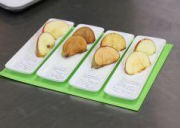Fruits are essential for maintaining a healthy diet as they are rich in various types of natural sugars and vitamins. Specifically, fruits are abundant with potassium, fiber, vitamin-C, and folate. Potassium helps us to maintain blood pressure, reduce blood cholesterol, and prevent heart disease. Fibers are essential for reducing constipation and diverticulosis. Folate causes our body to form red blood cells. Also, type 2 diabetes, stroke, heart disease, hypertension, and cancer can be prevented by consuming fruits. However, fruits’ effect on maintaining health may be disrupted with a chemical process, called browning in fruits.
Browning is a process where blackish or brownish color appears on the surface of the fruits and is classified into two sections, enzymatic browning and nonenzymatic browning. Non-enzymatic browning occurs when a brownish substance shows up through a chemical reaction without enzymes involved in the reaction. Meanwhile, enzymatic browning occurs with the reaction of polyphenol oxidase enzymes. Among those two processes, enzymatic browning is the key point consumers should focus on.
Enzymatic browning is caused by slicing fruits or exposing them to sunlight. When the fruits are sliced, the tissue of the fruit is damaged. Then, the polyphenol oxidase enzyme exposes to an oxygen, oxidizing phenols into quinones. The quinones are polymerized through reactions and create a melanin, a brown-colored substance. As enzymatic browning happens with the existence, enzymatic browning is prevented by removing oxygen. However, when the fruits are reexposed to oxygen. the browning processes.

https://www.ifst.org/lovefoodlovescience/resources/fruit-and-vegetables-enzymic-browning
Enzymatic browning highly affects fruits’ nutritional value. During the process of enzymatic browning, phenolic oxidizes into quinones. This means the amount of phenolic compound decreases as enzymatic browning is created. Lack of phenolic compounds can reduce the antioxidant capacity. In other words, it increases the chance of cellular damage and inflammation. If humans do not consume lots of phenolic compounds, there are higher percentages of chronic diseases. Vitamin C is an antioxidant that inhibits enzymatic browning in fruits. Vitamin-C tries to reduce quinones. It causes significant loss of vitamin-C. It is very crucial as vitamin-C is the main nutrient of fruits.
As enzymatic browning causes nutrient loss of fruits, many researchers studied a method of prevention of enzymatic browning. Until recently, researchers have identified three main ways to inhibit polyphenol oxidase phenols: using physical, chemical, and polyphenol oxidase inhibitors.
For physical approaches, the strategies to suppress polyphenol oxidase have been studied for many years. Heat treatment has been successfully used to inhibit the enzymatic. browning. However, this approach cannot control the browning. To solve this problem, mild and nonthermal methods that include disrupting chemical bonds of proteins have been tested. Also, ultrasound methods have been investigated for many years. Adding to an ultrasound, the pulsed light effect has been researched for a possible treatment of the enzymatic browning. Moreover, cold plasma technology, a nonthermal technique, has been used to inhibit polyphenol oxidase activity.
There are many chemical approaches that have been studied for a long time. Nevertheless, a lot of those approaches have been banned due to safety issues. For example, sulfur dioxide and sulfites have been banned since they may cause allergic reactions. Ascorbic acid is a current method that is available in the fruit industry. Recently, researchers are using common reducing and acidifying agents to reduce polyphenol oxidase activity. For instance, the formation of hydrogen bonds, ionic contract, and utilizing electronegativity are the main examples.
Even though there were many efforts to control the enzymatic browning, researchers could not find a suitable way to reduce the enzymatic browning. It will be an unresolved homework for the researchers and the fruit industries.
Works cited
https://www.scientificamerican.com/article/fruits-gone-bad-discover-enzymatic-browning/ https://www.hhhealth.com/blog/the-health-benefits-of-fruit/
https://www.mdpi.com/2311-7524/9/1/57 https://www.sciencedirect.com/science/article/abs/pii/S0963996923001680?via%3Dihub https://ift.onlinelibrary.wiley.com/doi/10.1111/1541-4337.13059
https://www.frontiersin.org/journals/plant-science/articles/10.3389/fpls.2024.1342639/full https://www.researchgate.net/publication/378031713_THE_EFFECT_OF_DRYING_ON_TH E_PHYSICAL_AND_CHEMICAL_PROPERTIES_OF_FRUITS
https://www.betterhealth.vic.gov.au/health/healthyliving/fruit-and-vegetables
https://www.ukessays.com/essays/biology/effect-of-vitamin-c-on-apple-browning-biology-es say.php
https://pubs.acs.org/doi/10.1021/acs.jafc.2c07828
By: Seunghu Chi

